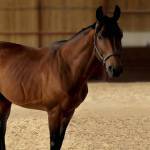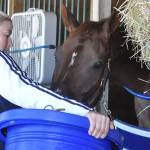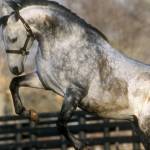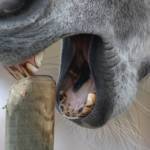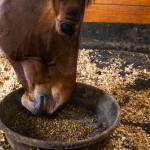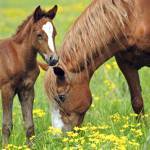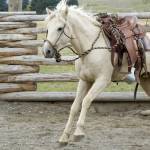Friesian Horses Capture the Imagination
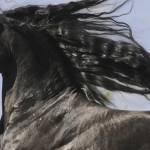
If Margaret Mitchell had ever seen a Friesian horse, Rhett Butler would have ridden one. They are the ultimate romance novel horses with their dark as night coats, commanding presence, proud stature and powerful gaits. Goliath, the stallion that carried Navarre in Lady Hawke and Tornado, Zorro’s fearless steed, albeit called another breed in the movie, were both Hollywood treasures that have excited legions of horse lovers.
It takes a special breed of horse to win the immediate adoration of horsemen and laymen together and the Friesian was tailor-made to fit the bill. While not terribly large in size – average Friesians stand between 14.3 and 15.3 hands – they are possessed of a presence that towers above their actual height. They carry the heavy bone structure and muscling of their draft-sized ancestors but move with a grace and agility that make them suitable for driving, dressage or pleasure riding.
Luxurious long, thick and crinkled manes, tails and forelocks add flair to the horses’ black lustrous coats. Combine this with a broad face complemented by large expressive eyes and smaller, slightly tipped ears and the horse is an impressive masterpiece of equine beauty. Friesian horses have a long history, perhaps one of the longest of any breed. It is believed that the modern day versions can be traced back to the prehistoric Equus robustus, an enormous cousin to Przewalski’s horse, that roamed the northern province of Friesland in the Netherlands around 500 BC. Friesian cavalry officers used their horses to help them as they guarded Hadrian’s Wall around 150.
The bones of these horses led archeologists to believe they had characteristics very similar to today’s Friesians. It is said that William the Conqueror used a “Friesianlike” stallion to carry him to victory in 1066. Many a crusader was similarly mounted.
Through the first half of this millennium there are numerous accounts of Friesian horses being bought and sold as beasts of burden, trotting racehorses and war horses. It was a mark of distinction to own a Friesian horse and many of the great Dutch painters depicted their wealthy subjects on or near one of the country’s distinctive horses.
By 1566 the people of Friesland expressed their concern for their unique animals by placing the first of many bans on their exportation, particularly those horses “fit for war.” However, even the “war horses” of the Netherlands could not keep their country from being overrun by first the Spanish, who brought with them their Andalusian horses, and then by the French who had designs on further crossbreeding. The end result of these influences was almost the demise of the breed. Again the people of Friesland stepped in to safeguard their horses by instituting breeding practices that served to protect the bloodlines.
These protective measures were to come into play many times in the past 400 plus years. In 1879 a group of 22 men from all over Friesland gathered in Roordahuizum to discuss a registry for Friesian cattle. At the same meeting a lengthy argument ensued over their horses. They agreed on beginning two registries for their horses to accommodate those people wanting to protect the purebred Friesians and those who wanted to register their crossbreds. This division of registries was to happen again more than a few times as the breed became further refined.
The first purebred registry was named “Het Friesch Paarden-Stamboek” (FPS). It is the oldest horse studbook in the Netherlands and is still one of the top two registries for Freisian horses in the world. The early entries into the studbook were not always jet black; some were reddish brown with white markings. The preference for solid black became so pronounced that by the early 1900’s black was the only recognized color for the breed. In 1948 a proposal was made not to allow any horses with white markings into the registry. Today there are over 5,000 horses registered in the FPS with separate divisions for fillies and colts, mares, stallions and geldings. Purebred parentage does not grant a foal automatic registration. The FPS has rigid standards every horse must meet prior to receiving complete registration. Foals receive an identifying microchip shortly after their birth. When these horses reach three years of age the horses are presented to FPS sanctioned judges who then determine if the individual is of sufficient quality to merit registration. If the horse passes the rigorous judging criteria, it then receives complete papers and the FPS brands.
While the FPS is considered the first registry for Friesians, it is not the only registry. The German registry Friesenpferde-Zuchtverband e. V (FPZV) was formed in the 1970’s to promote and preserve the Friesian horse in Germany. The German government sanctions this organization, making it different from the FPS organization within the country. FPZV is perhaps the best known of any of the other registries and it also has very strict standards for registration. The FPZV recognizes the Dutch criteria for judging and conformation but differs in three major areas: the judging of the movement of the horses, mare performance testing and the allowance of crossbreeding. Gaits are judged as 60% of total scores for both registries, but FPZV judges rate each gait differently than FPS judges. Mares are subjected to longer testing periods in both driving and riding for registration in FPZV.
Perhaps the biggest difference between the two registries is in the area of crossbreeding. This practice has long been a part of Friesian history. Many breeds can trace their lineage to a Friesian mare or stallion, most notably the Oldenburg that was mainly founded on Friesian blood. The Germans frown on the crossbreeding of the stallions registered with them but are even more particular with the mares. The use of a purebred Friesian mare for crossing with another breed is strictly prohibited.
The FPZV will recognize a crossbred horse if the stallion is an approved Friesian, if the mare is registered by a recognized breed registry and if the mare owner is a member of FPZV or its associate in the United States, the Friesian Horse Society. The resulting foals will be issued a birth certificate and be allowed the opportunity to be registered in a specific crossbred studbook after DNA testing proves their parentage and they are judged and branded by the FPZV. The offspring of these crossbreds will not be recognized. Horses registered with FPS are recognized as equals by the FPZV but the reverse is not considered to be the case.
There are many organizations in other countries like the Friesian Horse Society in the United States that are affiliated with one or the other of these two groups. In the United States the group affiliated with FPS is the Friesian Horse Association of North America. The Australian Friesian Horse Society, which currently has just over 70 registered horses, is associated with FPS. There are also recognized Friesian organizations in Canada, Scotland, Austria, Switzerland, France and South Africa, where many of the mounted police ride Friesian horses.
Judges from both the Dutch and the German registries travel no more than once a year to some of these countries to assess young horses for inclusion in their registries. Because of the strict registration policies of both organizations, the Friesian horse as a breed has been able to maintain very specific characteristics that are highly valued by their owners. Aside from their exceptional appearance, the horses are also, like many of their larger counterparts in the draft world, gentle. A South African woman who purchased a Friesian to serve as a mount for her 53-year-old mother stated, “After three months of looking at countless horses of different breeds, I saw Sylvester, a 3 1/2 year old Friesian stallion, and fell in love with him on the spot. He fulfilled all of my mother’s requirements except for the fact that he was entire. I still can’t believe how willing to please and quick to learn he was. I have never had the pleasure of handling such a special horse and I feel honored that I have had the opportunity.”
The unique personality of the Friesian also makes him quite trainable in a number of equine sports. Carina Jefferson of the Australian Friesian Horse Society explained, “The Friesians here compete mostly in dressage and driving. Dressage is becoming more popular lately, possibly due to the increased promotion worldwide of the Friesian as a riding horse rather than only a driving horse.”
With their attractive appearance, gentle nature, and willingness to learn, the Friesians are a popular attraction at equine events all over the world. At Equitana USA in 1998 the crowds were treated to an exhibition of Friesian horses put on by Proud Meadows Equestrian Center from Cedar Hill, Texas. The farm stands and exhibits six FPZV approved stallions including Jorrit, the only horse to achieve a perfect score of 10 in the freestyle dressage at Equitana Europe in 1997. Gay Norman, the administrative assistant for the center, said, “In Louisville, Kentucky last year one of our stallions, Tjerk, came into himself. He had always been a bit of an introvert but when he performed and heard the applause, he found himself. He became an extrovert. As exciting as it was to watch that, it was even more incredible to watch how he responded to the people who came to see him. One lady in a wheelchair had been trying to get close enough to pet some of the other horses on display there. They would see the wheelchair and go to the back of their stalls. Tjerk came right over to the stall door and put his whole head in her lap. She was crying as she stroked his head and so were we. It was beautiful. They are incredible animals with the most gentle of souls.”

